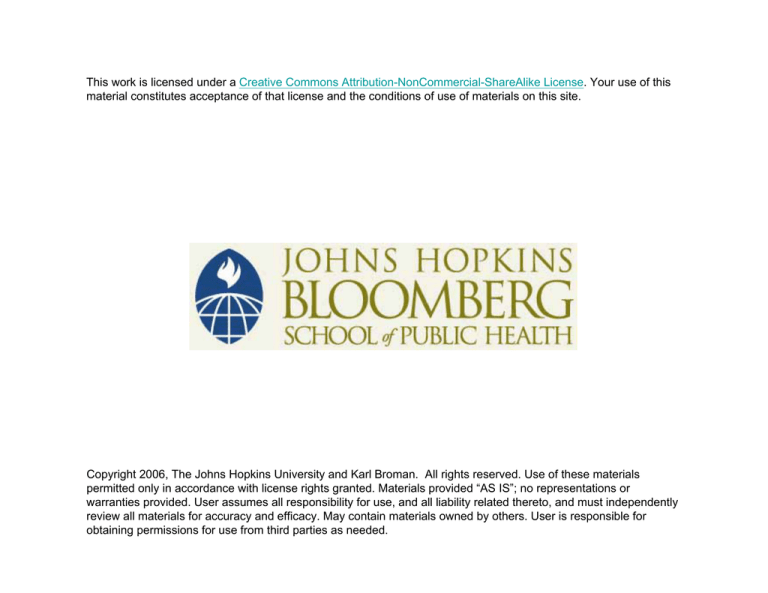
This work is licensed under a Creative Commons Attribution-NonCommercial-ShareAlike License. Your use of this
material constitutes acceptance of that license and the conditions of use of materials on this site.
Copyright 2006, The Johns Hopkins University and Karl Broman. All rights reserved. Use of these materials
permitted only in accordance with license rights granted. Materials provided “AS IS”; no representations or
warranties provided. User assumes all responsibility for use, and all liability related thereto, and must independently
review all materials for accuracy and efficacy. May contain materials owned by others. User is responsible for
obtaining permissions for use from third parties as needed.
Statistics for laboratory scientists
http://www.biostat.jhsph.edu/~kbroman/teaching/labstat/index.html
Statistics for laboratory scientists (140.615-616)
[ 3rd term syllabus | 4th term syllabus | R for Windows ]
Course summary
Introduces the basic concepts and methods of statistics with applications in the experimental biological sciences.
Demonstrates methods of exploring, organizing, and presenting data, and introduces the fundamentals of probability.
Presents the foundations of statistical inference, including the concepts of parameters and estimates and the use of the
likelihood function, confidence intervals, and hypothesis tests. Topics include experimental design, linear regression, the
analysis of two-way tables, sample size and power calculations, and a selection of the following: permutation tests, the
bootstrap, survival analysis, longitudinal data analysis, nonlinear regression, and logistic regression. Introduces and
employs the freely-available statistical software, R, to explore and analyze data.
Lecturer
Karl Broman
Office: E3612 SPH
Email: kbroman at jhsph.edu
Phone: 410-614-9408
Fax: 410-955-0958
Office hours: Mon & Fri 1:30-2:30pm (or by appointment, or just stop by)
Lectures
MWF 10:30-11:20 am (W4013 SPH)
Computer lab W 1:30-2:20 pm (W3025 SPH)
Discussion
W 2:30-3:20 pm (W2015 SPH)
Teaching
Assistant
Qing Li
Office: E3035 SPH
Email: qli@jhsph.edu
Office hours: By appointment
Syllabus
Third term
Fourth term
Textbook
ML Samuels, JA Witmer (2002) Statistics for the life sciences, 3rd ed, Prentice Hall [Required]
L Gonick, W Smith (1994) Cartoon guide to statistics. HarperCollins. [Recommended]
P Dalgaard (2002) Introductory statistics with R, Springer-Verlag [Recommended]
Calculator
A scientific calculator (with logarithms, exponents, trigonometric functions, simple memory and recall,
and factorial) will be necessary.
Computer
software
We will use the freely-available statistical software, R: cran.r-project.org
See the Notes on R for Windows page.
Basis for
grading
Third term
33%: 3 computer
labs
33%: 3 quizzes
34%: 1 exam
Fourth term
66%: 3 computer
labs
34%: 1 final project
[ 3rd term syllabus | 4th term syllabus | R for Windows ]
1 of 1
Last modified: Fri Jan 20 14:46:16 EST 2006
1/20/06 2:51 PM
3rd term syllabus
http://www.biostat.jhsph.edu/~kbroman/teaching/labstat/third/
Statistics for laboratory scientists I (140.615)
[ Main page | 4th term syllabus | R for Windows ]
Third term objectives
Graphical displays of data
Basic experimental design
Basic probability
Confidence intervals and tests of hypotheses
Third term syllabus
[Note: the following is subject to revision.]
Legend:
Date
N Notes C Code H Homework S Solutions L Labs
Topic
Reading
N
C
H
S
L
January 23 Overview; what is statistics?
25 Displaying data badly; data summaries
27 Experimental design
30 Observational studies
February 1 Probability, conditional probability
3 Examples, Bayes's theorem
6 More examples
8 Random variables, distributions, binomial, Poisson
10 Normal distribution, multiple random variables
13 Sampling distributions; Central limit theorem
15 More of the same
17 Maximum likelihood estimation
20 Confidence interval (CI) for the mean
22 CIs for differences between means, CI for population SD
24 Tests of hypotheses
March
27 Tests for differences between means
1 Calculation of sample size and power
3 Permutation tests and other non-parametric tests
6 Finish off permutation tests, sample size/power
8 Confidence interval for a proportion
11 Uses and abuses of tests
13 Transformations and outliers
15 Analysis of gene expression microarrays
17 Exam (10:30-12:30)
[ Main page | 4th term syllabus | R for Windows ]
1 of 1
Last modified: Wed Jan 18 10:28:30 EST 2006
1/20/06 2:49 PM
Statistics for laboratory scientists
Karl W Broman
Department of Biostatistics, Johns Hopkins University
Office: E3612 SPH; Email: kbroman@jhsph.edu
http://www.biostat.jhsph.edu/˜kbroman
TA: Qing Li (qli@jhsph.edu, E3035)
Outline
• Biostatistics
courses
• About this course
• What
• Logistics
• Grading
• Computer
package
is statistics?
Introductory statistics courses at JHSPH
611–612
Understand statistics in the literature
621–624
Actually do elementary statistics; focused
largely on observational data
651–654
More advanced; requires calculus
615–616 (this course):
• Like 621–622, but focused on experimental
rather than observational data.
• Should be able to enter 623–624 after (generalized linear models; multiple regression).
• Take both terms!
Logistics
Lectures:
MWF 10:30-11:20 (W4013 SPH)
Computer lab:
Discussion:
W 1:30-2:20 (W3025 SPH)
Office hours:
Karl: Mon & Fri 1:30-2:30 or by app’t (E3612 SPH)
W 2:30-3:20 (W2015 SPH)
Qing: By appointment (E3035 SPH)
Textbooks:
Samuels & Witmer (2002) Statistics for the life sciences
Gonick & Smith (1993) The cartoon guide to statistics.
[recommended]
Dalgaard (2002) Introductory statistics with R statistics.
[recommended]
Grading
Grade based on:
• 3 Computer labs (33%)
• 3 Quizzes (33%)
• 1 Exam (34%)
Other work:
• Homework and reading assignments
• Play with R
• Deep and careful thought
• Discussions
Computer package: R
Advantages
Disadvantages
+ Free
– No dedicated support
+ Available for Windows, Mac
OSX, Unix
– Complex syntax
+ Comprehensive
– Some simple tasks are
rather hard
+ Powerful graphics
+ Well-designed programming
language
+ Unlimited extensibility
+ Widely used by statisticians
+ Increasingly used for
microarray analyses
– Not point-and-click
What is statistics?
We may at once admit that any inference from
the particular to the general must be attended
with some degree of uncertainty, but this is not the
same as to admit that such inference cannot be
absolutely rigorous, for the nature and degree of
the uncertainty may itself be capable of rigorous
expression.
— Sir R. A. Fisher
What is statistics?
• Data
exploration and analysis
• Inductive
inference with probability
• Quantification
of uncertainty
Example 1
Goal:
Method:
Determine, by fluoresence, the concentration of
quinine in a sample of tonic water.
1. Obtain a stock solution with known concentration of quinine.
2. Create several dilutions of the stock.
3. Measure fluoresence intensity of each such standard.
4. Measure fluoresence intensity of the unknown.
5. Fit a line to the results for the standards.
6. Use line to estimate quinine concentration in the unknown.
Question: How precise is the resulting estimate?
80
Fluorescence intensity
60
40
20
0
0
5
10
15
20
25
30
35
Quinine conc (ppb)
Example 2
[Esposito et al., Infection and Immunity 69:4516–4520, 2001]
Children that have positive response to a pertussis antigen:
Vaccinated with DTaP-HBV: 3/38 (8%)
History of pertussis infection: 5/21 (24%)
Questions:
• How precisely can we estimate the chance of a positive response given vaccination?
• Are the above rates truly different?
Example 3
[Carroll, J Med Entomol 38:114–117, 2001]
Place tick on clay island surrounded by water, with two capillary
tubes: one treated with deer-gland-substance; one untreated.
Does the tick go to the treated or the untreated tube?
Tick sex
male
female
male
female
male
female
male
female
Leg
fore
fore
fore
fore
hind
hind
hind
hind
Deer sex
female
female
male
male
female
female
male
male
treated untreated
24
5
18
5
23
4
20
4
17
8
25
3
21
6
25
2
Example 3 (cont.)
Questions:
• Is the tick more likely to go to the treated tube?
• Do the sex of the tick or deer, or the leg from which the gland
substance was obtained, have an effect on the response of
the tick?
Example 4
For each of 8 mothers and 8 fathers, we observe (estimates of)
the number of crossovers, genome-wide, in a set of independent
meiotic products.
Question:
Do the fathers (or mothers) vary in the number of
crossovers they deliver?
Male meioses
1331
1332
1347
Family
1362
1413
1416
884
102
20
25
Total no. crossovers
30
35
Female meioses
1331
1332
1347
Family
1362
1413
1416
884
102
30
35
40
45
50
55
60
Total no. crossovers
Example 4 (cont.)
How do we think about this?
If there were no relationship between family ID and number
of crossovers in a meiotic product:
• What sort of data would we expect?
• What would be the chance of obtaining data as extreme
as what was observed?
Goals for the course
• Impart
the statistician’s view of the world
• Basics of statistics
– Basic experimental design
– Sampling distributions
– Confidence intervals
– Hypothesis testing
• Basic
statistical graphics
• Basic
knowledge of R


